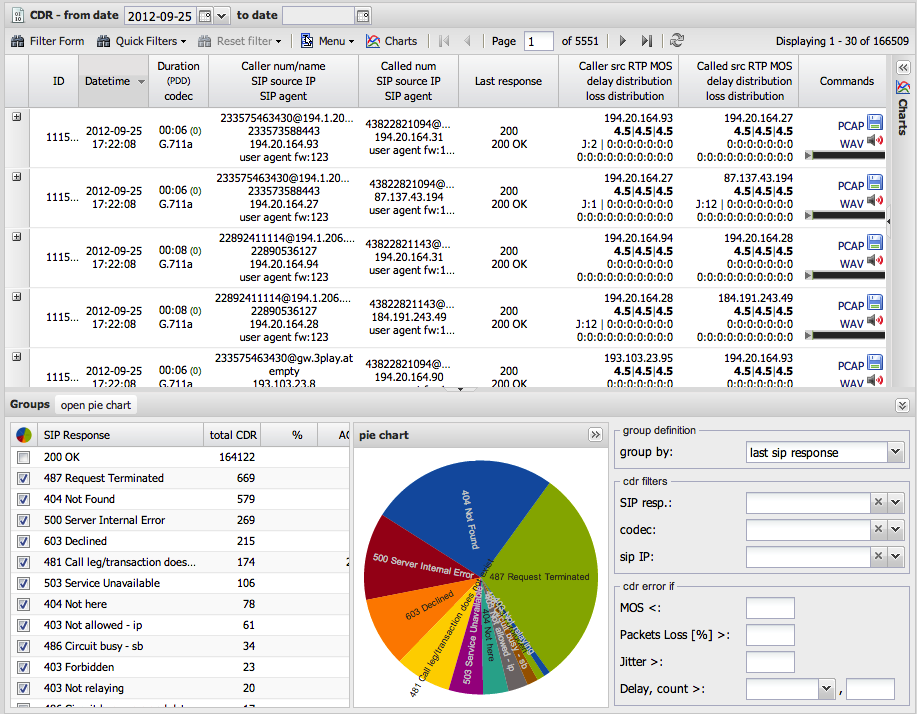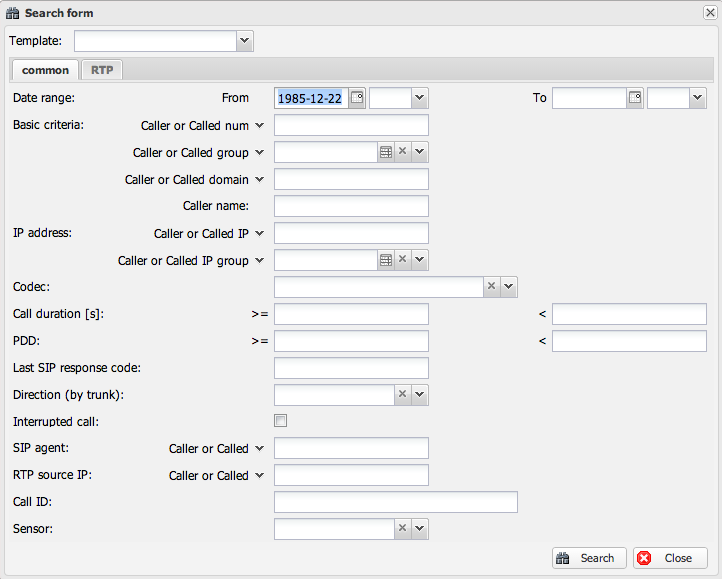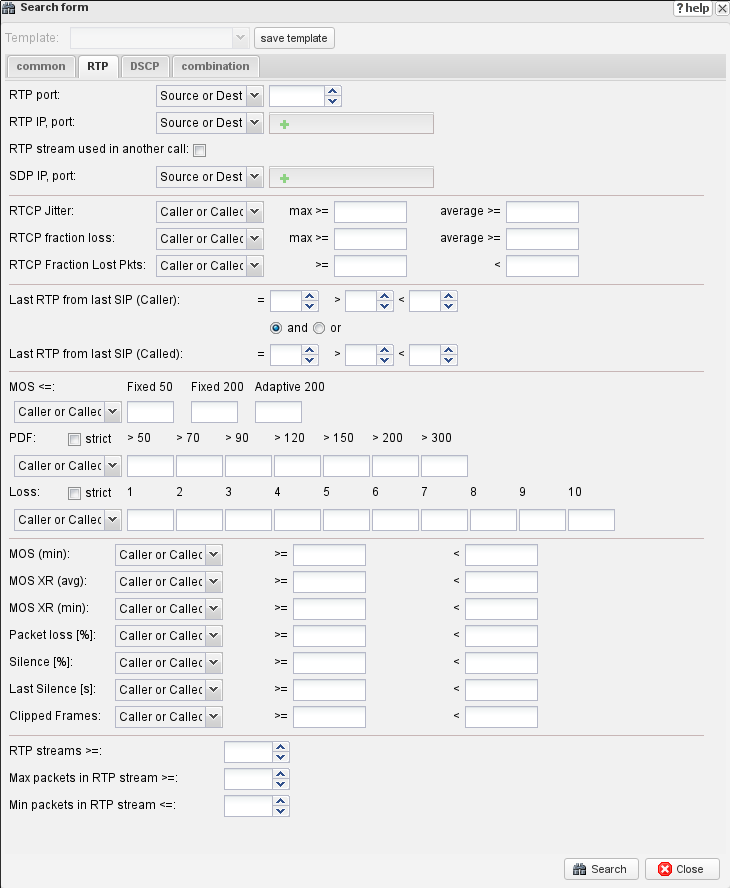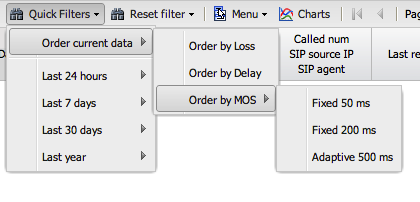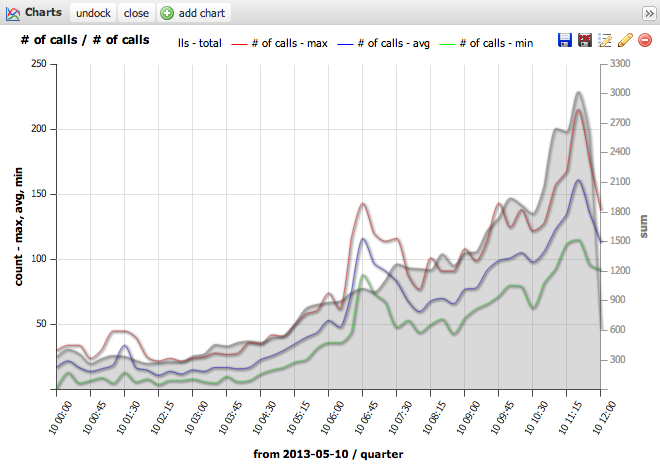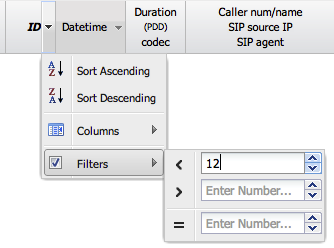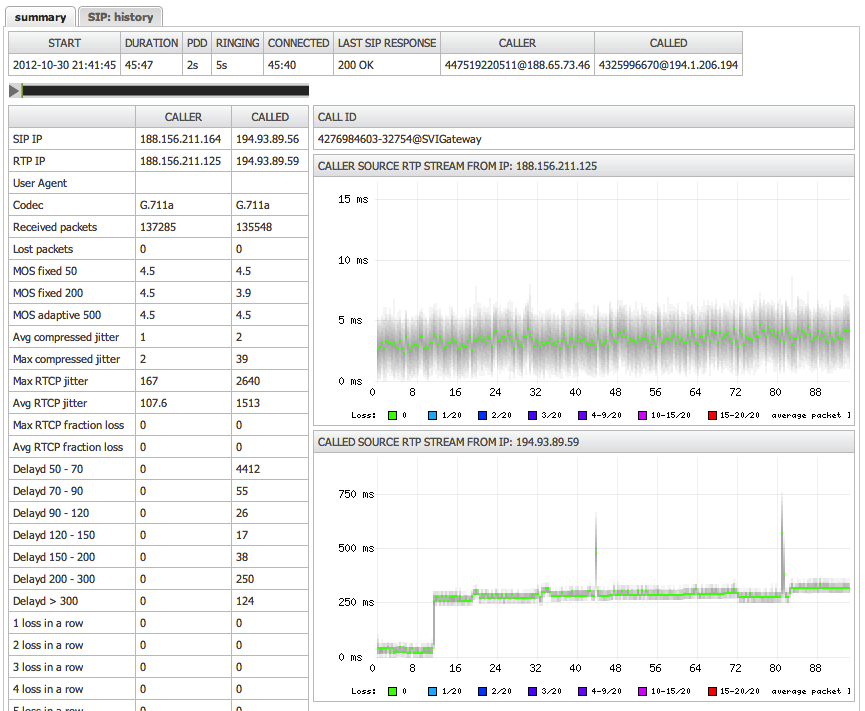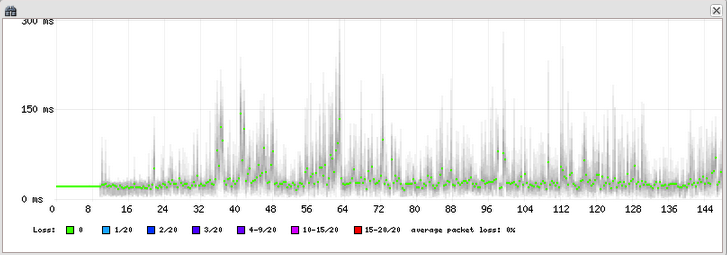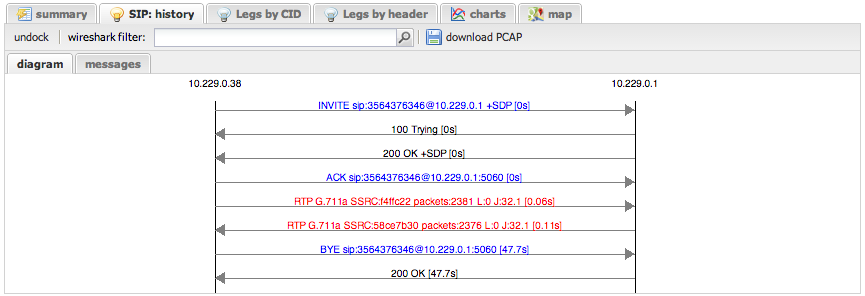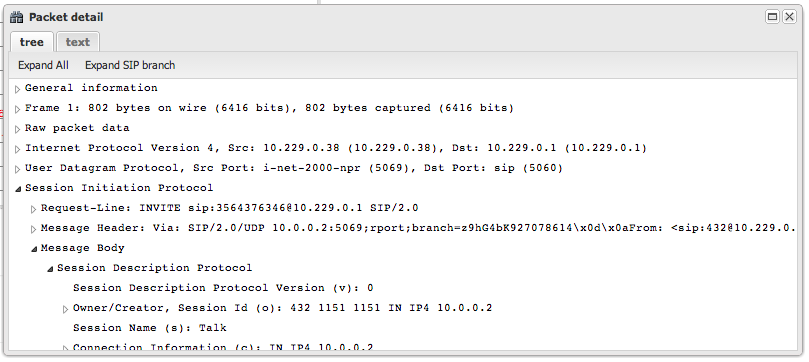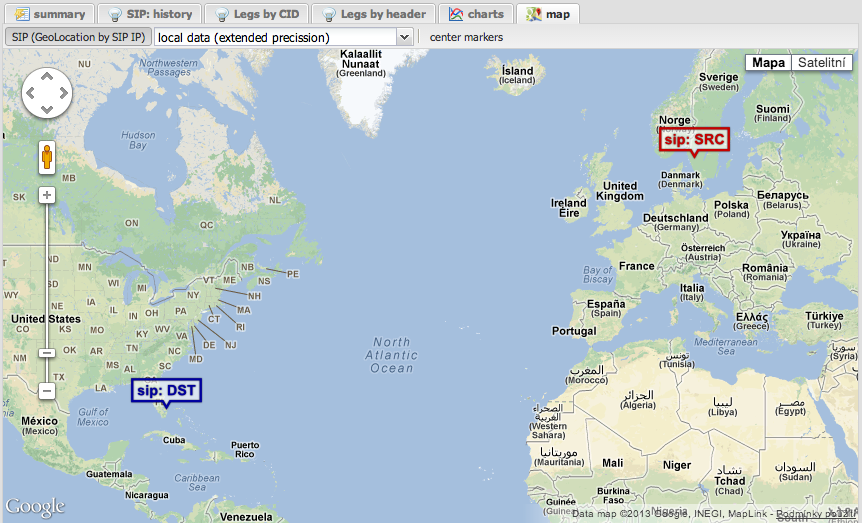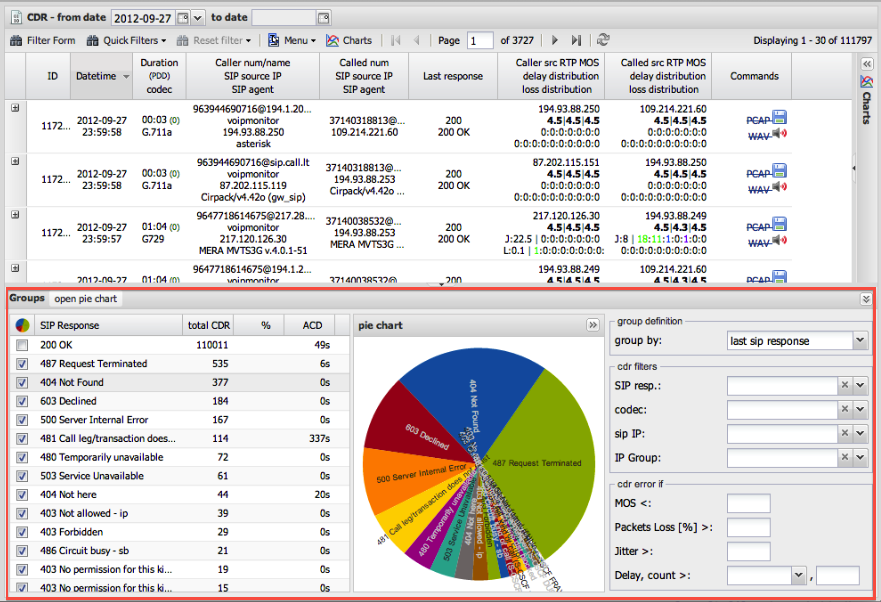Call Detail Record - CDR
This guide is a comprehensive tour of the main Call Detail Record (CDR) interface in the VoIPmonitor GUI. It explains every section, button, and feature, from searching for calls to analyzing their quality in detail.
What is a CDR?
A Call Detail Record (CDR) is a data record containing information about a single telephone call or communication session. In VoIPmonitor, each CDR captures:
- Call timing (start time, duration, connect time)
- Participant information (caller/called numbers, IP addresses, SIP agents)
- Signaling details (SIP messages, final response codes)
- Quality metrics (MOS scores, packet loss, jitter/delay statistics)
- Media information (codecs, RTP stream data)
The CDR view is the primary interface for searching, filtering, and analyzing these records.
Understanding the Main CDR View
The CDR view is the central hub for exploring your captured call data. It is comprised of three main sections:
- The CDR List: The main table displaying a paginated list of all finished calls.
- The Button Panel: A toolbar for accessing key functions like filtering, charting, and exporting.
- The Dashboard: A set of panels at the bottom that provide aggregated statistics for the currently displayed data.
The CDR List
This section details the components of the main call list, from the title bar to the information in each row.
Title Bar & Date Filter
At the very top, the title bar displays the current time range for the calls being shown. You can click on the dates to quickly change the filter.
Note: This quick date filter can be disabled on a per-user basis in user settings.
Button Panel
This toolbar provides access to the most important interactive features.
1. Filter Form
This is the most powerful feature for finding specific calls. Clicking this button opens a detailed search form with two main tabs.
Common Tab
This tab contains filters for general call attributes and participant information.
- Participant Filters: Search by
Caller/Called Number,Caller/Called IP, orCaller/Called Domain. You can use the%character as a wildcard (e.g.,222%finds all numbers starting with 222). You can also use commas for multiple values and!for negation (e.g.,222%, !223%). - Group Filters: Search by pre-defined
Caller/Called GroupsorIP Groups. - Call Attribute Filters: Filter by
Call Duration,Codec, orPDD(Post-Dial Delay) ranges. - SIP Filters: Filter by
Last SIP Response Code(e.g.,487, or4%for all 4xx codes),SIP Agent(phone type/firmware),SIP Call-ID, orSIP requests(select a specific SIP method such as INVITE, REFER, BYE, CANCEL, etc.). The SIP requests filter also supports counting occurrences - for example, to find calls with multiple SIP INVITEs (indicating multiple connections or re-INVITEs), set the filter tosip requests: INVITE count >= 3. This allows you to identify calls with complex signaling patterns directly from the CDR list without opening each call. Note: The "SIP requests" dropdown filter requiressave_sip_history = allorsave_sip_history = requeststo be configured in voipmonitor.conf. - Other Filters: You can also filter by the
Sensorthat captured the call or find allInterruptedcalls (those without a proper BYE).
RTP Tab
This tab allows you to find calls based on specific Quality of Service (QoS) metrics. This is essential for troubleshooting audio quality issues.
- RTCP Metrics: Filter by
JitterorFraction Lossvalues reported by the endpoints themselves via RTCP. - MOS: Find all calls with a Mean Opinion Score lower than a specified value.
- PDV (Jitter): Find calls with a specific number of Packet Delay Variation events in different time intervals (e.g., find all calls with at least 10 packets delayed by more than 120ms).
- Loss: Find calls based on patterns of consecutive packet loss.
- Silence & Clipping: If enabled on the sensor, you can find calls with a certain percentage of silence or a specific number of clipped audio frames. See Silence_detection for configuration details.
2. Quick Filters
This dropdown provides shortcuts for finding problematic calls (e.g., "Worst Calls by Loss") and gives you access to your saved filter templates.
= Saving and Reusing Filter Templates
You can save frequently-used filter criteria as templates and reapply them later, or combine multiple templates using OR logic.
- 'To save a filter template:*
- Apply your desired filter criteria using the Filter Form.
- Click the Save filter template button (usually shown as a save/disk icon in the filter area).
- Enter a descriptive name for your template (e.g., "Calls dropped within 5 seconds").
- The template will appear in the Quick Filters dropdown menu for future use.
- 'To apply a saved filter template:*
- Click the Quick Filters dropdown.
- Select your saved template from the list.
Combining Multiple Templates (OR Logic)
When you need to find calls matching multiple different criteria at once (for example, all types of call setup failures), use the Combination subtab within the filter form to merge templates using logical OR.
- 'To combine multiple filter templates:*
- Create and save separate templates for each type of filter you need (e.g., one for "Missing BYE", one for "Short calls", one for "5xx responses").
- Open the Filter Form and navigate to the Combination subtab.
- Select all the templates you want to merge.
- The system will return all calls matching ANY of the selected templates (OR logic).
Example use case:' Finding all call setup failures:
- Save template 1: "Interrupted calls" (missing BYE).
- Save template 2: "Short duration (0-5 seconds)" (calls answered then dropped).
- Save template 3: "5xx SIP responses" (server errors).
- Use the Combination subtab to select all three templates.
- Result: One unified CDR view showing all calls with ANY of these failure types.
3. Menu
This menu contains administrative actions.
- Delete: Delete selected CDRs and their associated files (PCAPs, audio).
- Export CSV: Export the current view of CDRs to a CSV file.
4. Charts
This button opens a window for adding overlay charts to your current CDR view, allowing you to correlate data visually. This feature is covered in detail in the Charts guide.
CDR List Columns
Each column in the CDR list provides key information and can be used for quick sorting.
Customizing Column Visibility
You can show or hide columns in the CDR list based on your preferences. This is useful when:
- You want to reduce visual clutter and focus on specific information
- Certain columns contain data that is causing performance issues
- Your display has limited screen space
To hide or show columns in the CDR view:
- Locate the column header area at the top of the table
- Click on the column visibility icon (typically a column or grid icon)
- Uncheck columns you want to hide, check columns you want to show
- The view will update immediately with your selection
Your column visibility preferences are stored in the GUI configuration (saved in the MySQL custom_config table) and persist across sessions.
Column Reference
A single row represents a single call.
| Column | Description |
|---|---|
| ID | The unique identifier for the call record (primary key in the database) |
| Sensor ID | The name of the sensor that captured the call (see Sensors configuration) |
| Datetime | The start time of the call (from first INVITE) |
| Duration (PDD) / Codec | Total call duration, Post-Dial Delay, and the audio codec used |
| Caller/Called Info | Number, Name, SIP IP, and SIP Agent. The red flag |
| Last Response | The final SIP response code and text for the call |
| RTP IP Addresses | Source IP addresses for the caller and callee RTP streams |
Quality Metric Columns
The quality columns provide at-a-glance indicators of call quality:
- MOS Column
 : Shows three parametric MOS scores based on different jitter buffer simulations:
: Shows three parametric MOS scores based on different jitter buffer simulations:
- F1: Fixed 50ms jitter buffer
- F2: Fixed 200ms jitter buffer
- Adapt: Adaptive jitter buffer (up to 500ms)
- Delay Column
 : Color-coded distribution of packet delay variation (jitter) events. See Jitter Analysis for interpretation.
: Color-coded distribution of packet delay variation (jitter) events. See Jitter Analysis for interpretation.
- Loss Column
 : Color-coded distribution of consecutive packet loss events. Red indicates burst losses which are more harmful to quality.
: Color-coded distribution of consecutive packet loss events. Red indicates burst losses which are more harmful to quality.
- PRICE Column: Shows billing costs calculated by the billing system. This column is hidden by default and must be enabled manually. To enable the PRICE column:
- Click the dropdown menu on the first column (the column header with the ID or the column selection icon)
- Select PRICE from the list of available columns
- The PRICE column will now display Customer (C:) and Operator (O:) prices for each call
Note: Costs only appear if billing is configured (see Billing Configuration) and "Enable by addresses" or "Enable by numbers" is checked in the billing settings. The "Default customer billing" checkbox ensures customer prices are applied to all source IPs by default, which may be useful for reporting purposes.
Understanding Sniffer vs RTCP Packet Loss
VoIPmonitor provides two different packet loss metrics measured from different network locations:
Interpretation Guide:
| Scenario | Likely Cause |
|---|---|
| RTCP loss > Sniffer loss | Network issue after the sniffer (Wi-Fi, last-mile, endpoint network) |
| Sniffer loss > RTCP loss | Monitoring point dropping packets (CPU overload, interface saturation) or RTCP reports not captured |
| High RTCP loss, good MOS | Packet Loss Concealment (PLC) effectively hiding scattered losses |
Troubleshooting tips:
- Trust RTCP loss for user experience issues - it reflects what the device actually received
- Use sniffer loss for network health monitoring in the segment you control
- When RTCP loss is higher, investigate the network path between sniffer and endpoint
Commands Column
- Download links for PCAP and WAV files
- Embedded audio player to listen directly in the browser
The CDR Detail View
Clicking the [+] icon at the beginning of any CDR row expands it to show the detailed analysis view with multiple tabs.
Summary Tab
This tab provides a detailed breakdown of call information, RTP statistics, and a full chronological log of all SIP messages for the call.
The Call Quality Graph
The most prominent feature is the detailed quality graph, which plots packet delay and loss over the duration of the call.
- Each vertical line represents a group of packets
- The colored dot represents the median delay (jitter)
- Packet loss is shown as red lines at the top of the graph
- Clock Drift: A graph that steadily climbs or descends
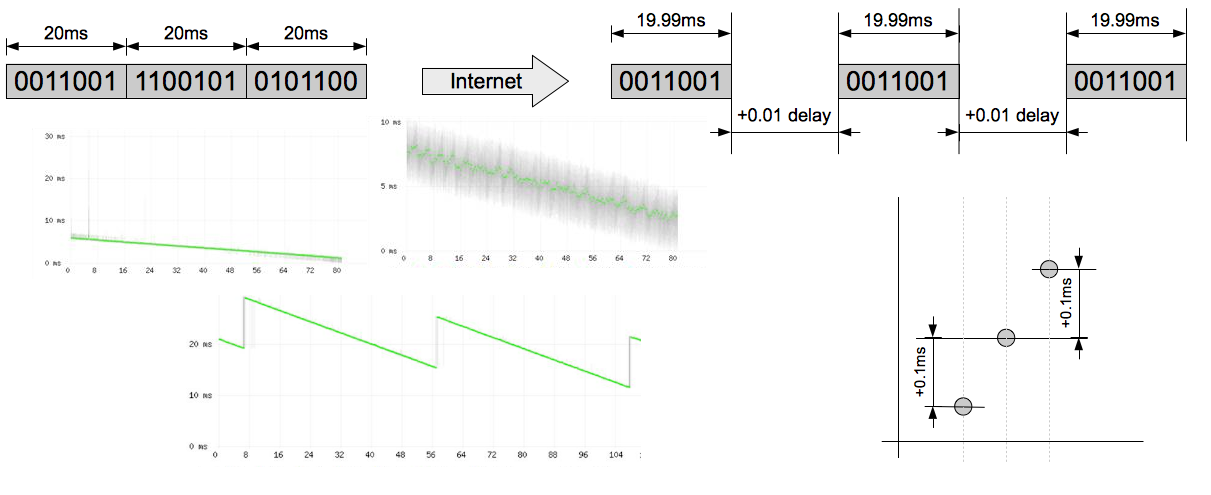 indicates a clock drift issue between the sending device and the sensor, not necessarily a network problem
indicates a clock drift issue between the sending device and the sensor, not necessarily a network problem
How Delay Causes Packet Loss (Jitter Buffer Behavior)
The graph plots delay (median delay/jitter), not constant one-way latency. This distinction is important because large delays directly cause packet loss in real-world calls.
Here is what happens when you see increasing delay on the graph:
1. RTP packets normally arrive every 20ms (for standard codecs) 2. When the delay increases (the dot moves higher), packets are arriving later than expected 3. The receiving device uses a jitter buffer to smooth out these variations 4. If a packet arrives too late (exceeding the jitter buffer capacity, typically 50-200ms depending on the device), it gets skipped during audio playback 5. VoIPmonitor detects this as missing sequence numbers and reports it as packet loss
This is why you will often see patterns where: high delay regions on the graph correlate with red packet loss lines appearing nearby. The delay itself is not a quality issue per se, but when it becomes too large, packets get dropped because they cannot be played in time.
For detailed information on how jitter buffers work and how delay patterns affect MOS scores, see Jitter Buffer Simulation.
Received Packets (Caller / Called)
The "received packets" field in the CDR grid shows how many RTP packets the VoIPmonitor sniffer received FROM that endpoint, not how many packets the endpoint itself received.
| Field | Meaning |
|---|---|
| Caller → Received Packets | Number of RTP packets VoIPmonitor received from the caller (A-leg) |
| Called → Received Packets | Number of RTP packets VoIPmonitor received from the called party (B-leg) |
One-Way Stream Example: If you have a unidirectional RTP stream (caller → called only):
- Caller column shows: 73 packets (VoIPmonitor received 73 packets from the caller's stream)
- Called column shows: empty (VoIPmonitor received no packets from the called party)
This indicates that VoIPmonitor sniffed packets sent by the caller, but did not capture any return stream from the called party.
Bidirectional Stream: Both columns will have values when VoIPmonitor receives RTP packets from both endpoints.
SIP History Tab
This tab provides a powerful, Wireshark-like view of the call's signaling.
- Sequence Diagram: A visual representation of the SIP message flow between endpoints
- Message Table: A text-based list of all SIP messages and RTP streams
- Packet Detail: Clicking on any message opens a window with a fully decoded tree view of the packet, similar to Wireshark
Legs by CID / Legs by Header Tabs
These tabs are used to find related call legs in complex call scenarios. For detailed information about call correlation, see Merging_or_correlating_multiple_call_legs.
- Legs by CID: Finds other calls that share the same numeric part of the
Fromheader tag within a few seconds of the original call. This is useful for finding the other legs of a call that was routed through a PBX.
- Legs by Header: A more powerful method that correlates calls based on a shared identifier in a custom SIP header (configured by
match_headerinvoipmonitor.conf). This is essential for tracing a single call across multiple proxies or SBCs where the Call-ID changes at each hop.
Charts Tab
This tab displays a set of predefined and custom charts applied specifically to the context of the selected call (e.g., showing trends for the caller number). This allows for quick historical analysis without leaving the CDR view.
Map Tab
This tab attempts to geolocate the source and destination SIP IP addresses on a world map using a GeoIP service.
The Dashboard Panels
The panels at the bottom of the screen provide aggregated views of the data currently displayed in the CDR list.
- Group By: You can group the data by
Last SIP Response,Codec,SIP IP, or predefinedIP Groups - Charts: The middle section displays a pie chart of the grouped data
- Filters: Clicking on any item in the group grid (e.g., clicking on the "200 OK" response) will instantly apply it as a filter to the main CDR list above
Trend Analysis for Capacity Planning
The grouping tab supports trend analysis that helps with capacity planning. When you group by source or destination IP (SIP IP) or predefined IP Groups, you can:
- View Trends by Source/Destination IP: Navigate to the Grouping tab at the bottom of the CDR view and select "SIP IP" as the grouping option. This allows you to visualize call volume trends for specific source or destination IP addresses over time.
- Capacity Planning Use Case: By analyzing trends grouped by IP address, you can identify high-traffic sources or destinations that may require scaling. This is particularly useful for:
- Planning additional bandwidth for SIP trunks
- Identifying growth patterns for customer traffic
- Forecasting hardware needs based on IP address trends
- CDR Trend Alerts: In addition to viewing trend data interactively, you can configure alerts to trigger automatically based on CDR trends. See Alerts for information on setting up trend-based alerts for proactive capacity planning.
Related Documentation
- Database_structure - Technical reference for CDR database columns
- Comprehensive_Guide_to_VoIP_Voice_Quality - In-depth guide to MOS, jitter, and quality metrics
- Merging_or_correlating_multiple_call_legs - How to correlate call legs across systems
- Silence_detection - Audio analysis features (silence/clipping detection)
- Reports - Generating reports from CDR data
AI Summary for RAG
Summary: The CDR (Call Detail Record) View is the primary interface in VoIPmonitor GUI for analyzing captured calls. It consists of three main sections: the CDR List (paginated call records), Button Panel (filtering and export tools), and Dashboard (aggregated statistics). The Filter Form provides powerful search capabilities through two tabs: Common (participant info, duration, SIP filters) and RTP (quality metrics like MOS, jitter, packet loss). Filter templates can be saved and reused, and multiple templates can be combined using OR logic via the Combination subtab to find calls matching different criteria simultaneously (useful for finding all types of call setup failures). Each CDR row displays call timing, participant information, and quality metrics including three MOS scores (F1, F2, Adaptive) based on different jitter buffer simulations. The RTCP column shows endpoint-reported metrics; when RTCP loss is higher than sniffer loss, it indicates network issues after the monitoring point (Wi-Fi, last-mile). The Dashboard panels at the bottom support trend analysis for capacity planning - you can group by SIP IP and view trends by source/destination IP addresses to identify traffic growth patterns and plan bandwidth or hardware scaling. The Detail View (accessed by expanding a row) includes the Summary tab with quality graphs, SIP History tab with Wireshark-like packet analysis, and Legs by CID/Header tabs for correlating related call segments across systems.
Keywords: CDR, call detail record, GUI, filter, search, MOS, jitter, PDV, packet loss, quality metrics, SIP history, sequence diagram, call legs, correlation, dashboard, group by, RTCP, sniffer loss, endpoint loss, trend analysis, capacity planning, source IP, destination IP, SIP IP, traffic trends, SIP requests filter, INVITE count, multiple connections, re-INVITE, filter template, save filter, Combination subtab, OR logic, combine filters, quick filters
Key Questions:
- How do I use the CDR view to find specific calls?
- How can I view trends by source or destination IP in the CDR view?
- How can I filter calls by quality metrics (MOS, jitter, loss)?
- What do the MOS F1, F2, and Adaptive scores mean?
- How do I view the SIP message flow for a call?
- What is the difference between Legs by CID and Legs by Header?
- How do I correlate related call legs across multiple systems?
- What does the quality graph show and what indicates clock drift?
- How do I use the dashboard panels to analyze call statistics?
- What is the difference between sniffer loss and RTCP loss?
- Why might RTCP loss be higher than sniffer loss?
- How do I identify calls with multiple SIP INVITEs or multiple connections?
- How can I use the SIP requests filter to count and filter by the number of SIP messages?
- How do I save a filter template in the CDR view?
- How do I use the Combination subtab to combine multiple filter templates with OR logic?
- How can I find all types of call setup failures at once using filter templates?
